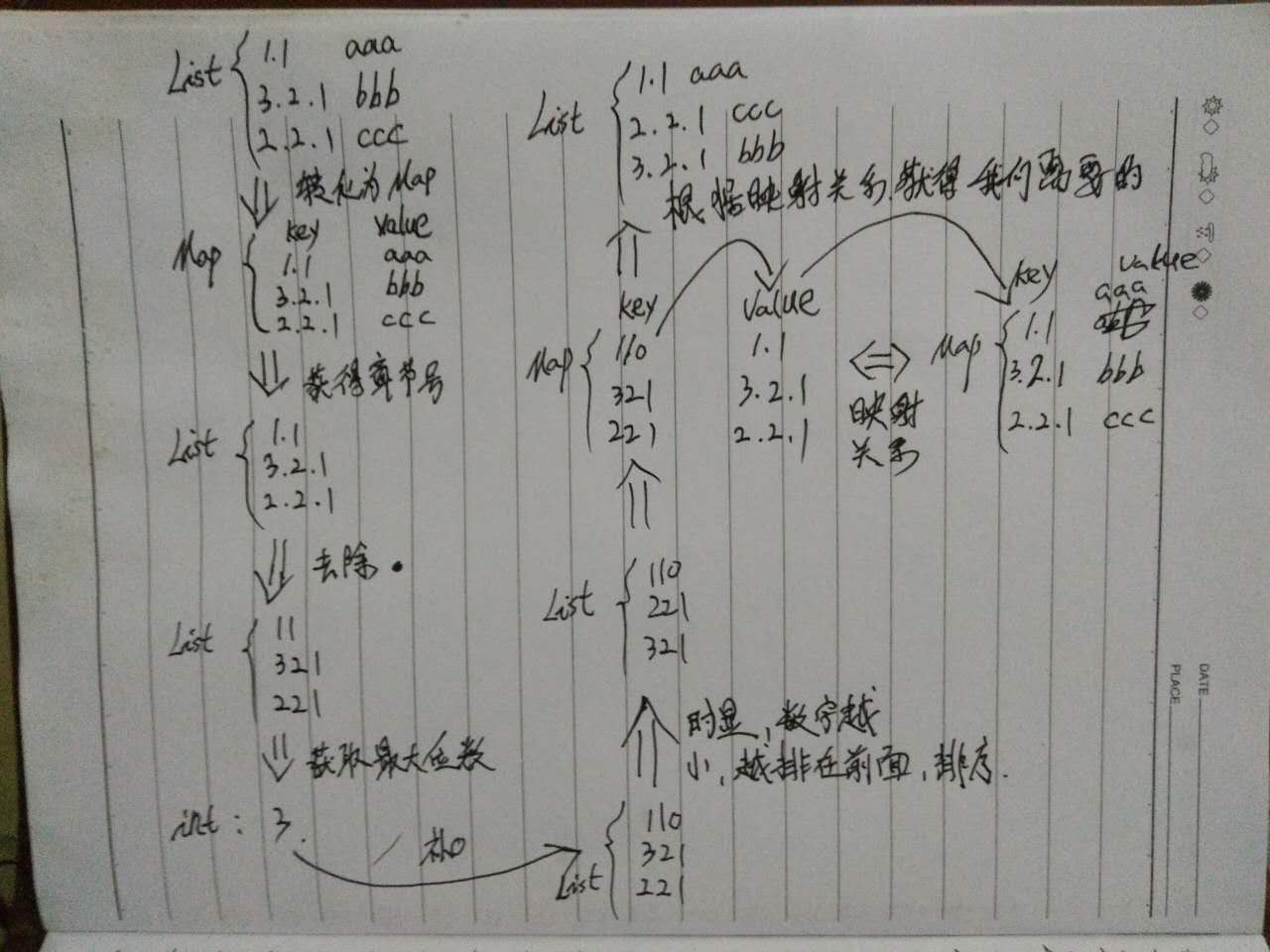Heim >Java >javaLernprogramm >Beispiele für die Kapitelsortierung in realen Java-Projekten
Beispiele für die Kapitelsortierung in realen Java-Projekten
- 黄舟Original
- 2017-01-19 11:21:361782Durchsuche
Stellen Sie eine Frage
Wie sortiere ich die Kapitel in einem echten Projekt? ? ?
Das Problem lösen
Das Folgende ist ein Kapitelsortierungsproblem in einem realen Projekt. Ich hoffe, dass Programmierer, die in Zukunft auf dieses Problem stoßen, eine Referenz liefern können Ich hoffe, dass ich gerade erst mit dem Lernen begonnen habe. Für Programmierstudenten kann es als Beispiel für die Praxis usw. verwendet werden. Das Bild ist die Idee und der Code ist die Umsetzung.

[code]package com.hwy.test;
import java.util.*;
/**
* 章节排序
* Created by Ay on 2016/7/9.
*/
public class ChapterSortTest {
public static void main(String[] args) {
/** 从数据库加载数据 **/
List<String> chapterList = getDataFromDB();
/** 章节list转化为map **/
Map<String,String> chapterMap = listChangeToMap(chapterList);
/** 获得章节号 **/
List<String> chapterNum = getChapterNum(chapterMap);
/** 章节号去除点 **/
Map<Integer,String> chapterNumNoDot = removeDot(chapterNum);
/** 获取数字最大长度 **/
int maxLength = getChapterNumMaxLength(chapterNumNoDot.keySet());
/** 获取补0后的列表 **/
List<String> fillZeroChapterNum = fillZero(maxLength,chapterNumNoDot);
/** 排序 默认是升序,刚好是我们需要的**/
Collections.sort(fillZeroChapterNum);
/** 重组map对象**/
List<String> sortChapterList = getSortChapterMap(fillZeroChapterNum,chapterMap,chapterNumNoDot);
/** 打印信息 **/
if(sortChapterList != null){
for(String key:sortChapterList){
System.out.println(key);
}
}
}
/**
* 获得排序后的map
* @param fillZeroChapterNum
* @param chapterMap
* @return
*/
public static List<String> getSortChapterMap(List<String> fillZeroChapterNum,Map<String,String> chapterMap,Map<Integer,String> chapterNotDot){
if(null == fillZeroChapterNum || fillZeroChapterNum.size() == 0) return null;
if(null == chapterMap) return null;
List<String> sortChapterList = new ArrayList<>();
for(String temp:fillZeroChapterNum){
sortChapterList.add(chapterNotDot.get(Integer.parseInt(temp.replace("0", ""))) + " " + chapterMap.get(chapterNotDot.get(Integer.parseInt(temp.replace("0", "")))));
}
return sortChapterList;
}
/**
* 补零操作
* @return
*/
public static List<String> fillZero(int maxLength,Map<Integer,String> chapterNumNoDot){
if(null == chapterNumNoDot || chapterNumNoDot.size() ==0) return null;
List<String> fillZeroList = new ArrayList<>();
for(Integer key:chapterNumNoDot.keySet()){
fillZeroList.add(key + getNeedZero(maxLength - (key + "").length()));
}
return fillZeroList;
}
/**
* 获得需要0的个数
* @param num
* @return
*/
public static String getNeedZero(int num){
if(num <1) return "";
StringBuffer sb = new StringBuffer();
/** 拼凑需要的0 **/
for(int i=0;i<num;i++){
sb.append("0");
}
return sb.toString();
}
/**
* 返回数组最大值
* @param a
* @return
*/
public static int max(int[] a){
// 返回数组最大值
int x;
int aa[]=new int[a.length];
System.arraycopy(a,0,aa,0,a.length);
x=aa[0];
for(int i=1;i<aa.length;i++){
if(aa[i]>x){
x=aa[i];
}
}
return x;
}
/**
* 获得章节号最大长度
* @param chapterNumNoDot
* @return
*/
public static int getChapterNumMaxLength(Set<Integer> chapterNumNoDot){
if(null == chapterNumNoDot || chapterNumNoDot.size() == 0) return 0;
Object[] chapterNumArr = chapterNumNoDot.toArray();
int[] chapterNum = new int[chapterNumArr.length];
for(int i=0;i<chapterNumArr.length;i++){
chapterNum[i] = chapterNumArr[i].toString().length();
}
return max(chapterNum);
}
/**
* 去除章节号中的点
* @param chapterNumList
* @return
*/
public static Map<Integer,String> removeDot(List<String> chapterNumList){
if(null == chapterNumList || chapterNumList.size() == 0) return null;
Map<Integer,String> rmDotChapterNumMap = new HashMap<>();
for(int i=0;i<chapterNumList.size();i++){
/** 把点替换成空 **/
rmDotChapterNumMap.put(Integer.parseInt(chapterNumList.get(i).replace(".","")),chapterNumList.get(i));
}
return rmDotChapterNumMap;
}
/**
* 获取章节号
* @param chapterMap
* @return
*/
public static List<String> getChapterNum(Map<String,String> chapterMap){
if(null == chapterMap) return null;
List<String> chapterNumList = new ArrayList<>();
for(String chapterNum:chapterMap.keySet()){
chapterNumList.add(chapterNum);
}
return chapterNumList;
}
/**
* 把list转变为map
* @param chapterList
* @return
*/
public static Map<String,String> listChangeToMap(List<String> chapterList){
/** 存到map中 **/
Map<String,String> chapterMap = new HashMap<>();
if(null == chapterList || chapterList.size() == 0) return null;
for(String chapter:chapterList){
chapterMap.put(chapter.split(" ")[0], chapter.split(" ")[1]);
}
return chapterMap;
}
/**
* 从数据库获取数据
* @return
*/
public static List<String> getDataFromDB(){
List<String> chapterList = new ArrayList<>();
chapterList.add("1.3.1 华丽新设计");
chapterList.add("1.4 思想流派");
chapterList.add("3.1 短小");
chapterList.add("3.2 只做一件事");
chapterList.add("2.11 别伴可爱");
chapterList.add("4.4.12 注释掉的代码");
chapterList.add("1.1 要有代码");
chapterList.add("2.1 介绍");
chapterList.add("8.5 使用尚不存在的代码");
chapterList.add("5.3.1 水平方向上的区隔与靠近");
return chapterList;
}
}Das Obige ist der Inhalt von Kapitelsortierungsbeispielen in echten Java-Projekten. Weitere verwandte Inhalte finden Sie auf der chinesischen PHP-Website (www.php. cn)!
Stellungnahme:
Der Inhalt dieses Artikels wird freiwillig von Internetnutzern beigesteuert und das Urheberrecht liegt beim ursprünglichen Autor. Diese Website übernimmt keine entsprechende rechtliche Verantwortung. Wenn Sie Inhalte finden, bei denen der Verdacht eines Plagiats oder einer Rechtsverletzung besteht, wenden Sie sich bitte an admin@php.cn
Vorheriger Artikel:Implementierungscode für den Java-AnmeldebestätigungscodeNächster Artikel:Implementierungscode für den Java-Anmeldebestätigungscode
In Verbindung stehende Artikel
Mehr sehen- Wie konvertiert man optional in Stream in Java 8?
- Wie behebt man Probleme bei der Ausgabeumleitung mithilfe der Java-Runtime?
- Wie validiere ich nicht positive Ganzzahleingaben in JTable-Zellen?
- Erweitertes Klassendesign mit Java Sealed Classes
- Kann Java/C# trotz der Verwendung virtueller Maschinen mit der Leistung von C mithalten oder diese sogar übertreffen?

